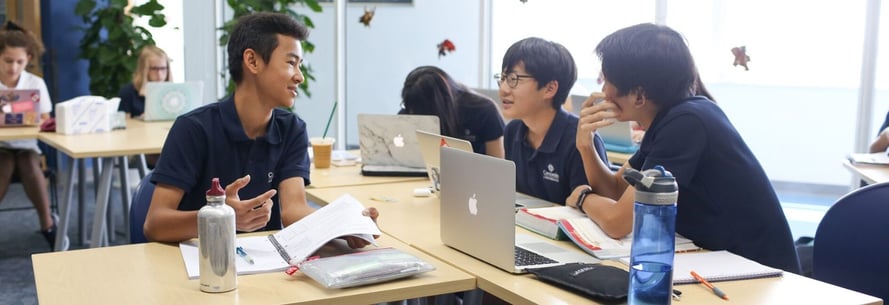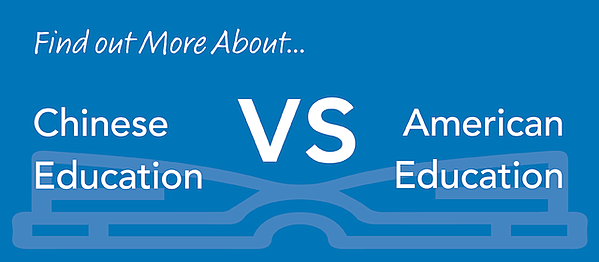 When it comes to American vs Chinese curriculums, the approaches to learning are vastly different.
When it comes to American vs Chinese curriculums, the approaches to learning are vastly different.
And whether the style is more traditional or innovative, finding the right curriculum for your children can be an intimidating task.
In this article, we aim to help you better understand the benefits of three of the most prominent learning styles from around the world. We then explore which ones are found in both a Chinese and American classroom.
We will focus on:
- Teacher-centered learning
- Student-centered learning
- Problem-centered learning
- The approach to learning used at Concordia Shanghai
Teacher-Centered Learning
Teacher-centered learning, also known as subject-centered learning, is the most universally recognized classroom style and is the technique most commonly used in Chinese schools.
In a teacher-centered classroom, the focus is on the educator who plans, prepares, and dictates a predetermined curriculum to an often quiet and passive audience.
This is the most formal style of the three approaches to learning covered in this article, as students work alone and refer to the teacher should any questions or concerns arise. Group discussions are not common as the teacher is viewed as the highest form of authority in the classroom.
Classroom management is often far easier for educators in a teacher-centered classroom, with student interaction and collaboration occuring much less than what is sometimes seen in an American or student-centered classroom.
Memorization, student focus, and rote learning are the key aspects of a teacher-centered learning environment, and this style is widely accepted as the standard by most Chinese families.
While this form of learning is the most strict on the surface, the intense focus on subject matters means students have a quiet and content-driven environment to study.
The downside of a teacher-centered based curriculum is students lack the opportunity to collaborate with their peers and develop their interpersonal skills in a classroom setting.
With the focus solely on memorizing dictations and producing exam results, often at any cost, students miss out on finding the fun in learning. This learning style also doesn’t take into consideration individual student learning needs, which can result in reduced student engagement and motivation.
“Recently schools in China have been working to add in more time for exploration, and non-traditional subject areas, seeking to blend in some principles found in Western education,” said Genevieve Ermeling, our assistant head of school at Concordia Shanghai in charge of teaching and learning.
With the rigid structure in a teacher-centered approach, and predetermined nature of each lesson, students are deprived of the chance to engage with the subject matter in their own way.
Chinese and American classrooms look very different from one another. To learn more about these differences and how studying an American curriculum helps prepare your children to study at an American university or wherever their best-fit school may be, click here.
 Student-Centered Learning
Student-Centered Learning
Shifting from the traditional teacher-led model of educating, a student-centered approach provides a more flexible learning environment.
In a student-centered classroom, also known as learner-centered, the focus shifts from solely on the teacher to the students as well.
In this environment, a teacher will often model the lesson and then allow students to interact with one another and the educator themselves to better understand coursework. Group work is encouraged, as are student questions and student-led responses, though the teacher is used as a knowledge reference.
The difference between a student-centered and a teacher-centered approach becomes most obvious when comparing classroom environments and the interactions between students and teachers.
“[While touring schools], if every classroom you go into is just a teacher talking to students, or if you’re in a classroom for 20 minutes and all you see is the teacher talking without the kids turning and engaging one another in conversation, that’s a red flag. You want to make sure students are interacting with each other, a balance between collaboration and teacher instruction,” said Ermeling.
Finding the right balance of student interaction and lesson engagement is the most difficult part of a student-centered curriculum, with the majority of this responsibility resting on the shoulders of the teacher. It can be labor intensive and time-consuming, and can also be difficult to balance student interests and actual student needs and outcomes.
While a classroom may be interested in one aspect of a subject, it’s up to the teacher to ensure that the required content is reached and understood.
Problem-Centered Learning
While teacher-centered and student-centered curriculums seem to be the opposite of each other, a problem-centered learning style focuses on the application of knowledge and the social context of skills.
Problem-centered learning focuses on the relevancy of curriculum content and uses real-world applications to guide student learning.
“We believe every child is a gift from God, entrusted to us by parents, so we take our promise to educate each child from a holistic approach to heart. We want to provide learning wrapped in relationships - knowing that who we learn with is as important as how and what we learn,” said Ermeling.
In a teacher-centered classroom, where students lack the opportunity to engage with one another to further explore subject matter, students may find themselves having only surface-level knowledge on the content and have difficulty applying it to real-world problems. With a problem-centered approach, it’s up to the teacher to help students learn how to look at a problem and find a solution.
“When you create a certain type of environment, you let the kids be who they want to be. If you have kids who feel empowered and know they can do something about a problem they see, that’s golden. At Concordia Shanghai, we talk about our vision transforming lives to be changed, we transform lives to be changed whether it’s in yourself, within your family, or change in the world,” said Ermeling.
Our Approach to Learning
At Concordia Shanghai, our approach is a hybrid between student and problem-centered learning.
“We use a learner-centered approach asking what are the enduring knowledge, skills, and mindsets students need to be equipped to navigate life,” says Ermeling. “Some of our curriculum uses inquiry and a problem/need centered approach, while other curriculum uses modeling and responsive teaching.”
We offer this approach because we want to design learning that helps students move what they learn from their short-term memory to their long-term memory.
“How we guide learning at different developmental ages or to foster different skills matters. There is not a one size fits all learning. We also design learning not just for the content, but also the skills and mindsets we'd like to foster.”
Our teachers are excited to provide an American style approach to learning for your children, which will help them get into their best-fit university. To discover the benefits of an American education and how it compares to a Chinese curriculum, click the link below.





